Blitzkrieg tanks in combat (part of 2)
Another thing is that the combat characteristics of most of them were not balanced, so their use was extremely difficult. Thus, the French tank “Somau” S-35, armed with an 47-mm gun and machine gun, had a maximum armor thickness of 56 mm, but a crew of three people: a driver, radio operator and tank commander, who was in the single-seater and overloaded with such number of duties that he simply could not successfully combine them all. He had to simultaneously monitor the battlefield, hit targets with a cannon and a machine gun, and besides, charge them. Exactly the same tower was on the tanks D-2 and B-1-BIS. Therefore, it turns out that a single unsuccessful development of French engineers lowered the combat capability of three types of combat vehicles of the French army, although the idea of such a unification itself deserves all approval. Tank B-1 was the heaviest, as it had a combat mass in 32 tons and a maximum armor thickness equal to 60 mm. His armament consisted of 75- and 47-mm guns in the hull and in the turret, as well as several machine guns, but the crew was only four people, so he also could not effectively serve this tank. So, his driver had to perform the function of the gunner 75-mm guns, which was charged by a special loader, the radio operator was busy with his radio station, while the commander, like on the S-35, was overloaded with duties, and had to work for three. The speed of the tank on the highway was 37 km / h, but on the ground was much less. At the same time, the high altitude made it a good target for German anti-aircraft 88-mm guns, from the shells of which even 60 mm armor could not save! Renault R-35 / R-40 was a typical representative of the post-war generation of French light infantry escort tanks. With a combat mass of 10 tons, this double tank had armor 45 mm thick, a short-barreled 37 mm SA-18 cannon and a machine gun paired with it. The speed of the tank was only 20 km / h, which was completely inadequate for the conditions of a new, maneuverable war.
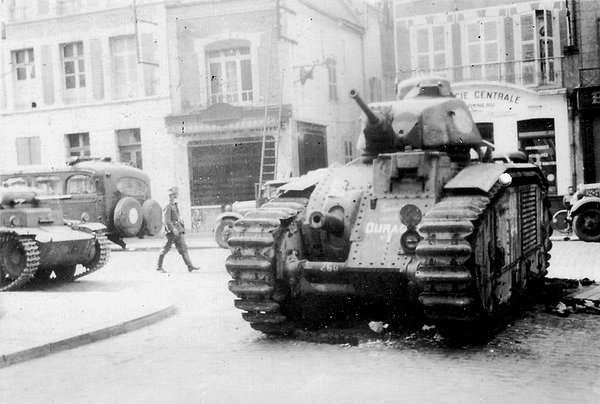
Padded B-1 in the square of the French city.
In May, 1940, the machines of this type, there were 1035, and another part was in reserve. More perfect, in any case, in terms of armament and speed, can be considered a tank of the company “Hotchkiss” H-35 and in particular its subsequent modification H-39. Unlike machines of earlier releases, the X-NUMX-mm SA-37 cannon was mounted on it with the barrel length 38 of caliber and the initial velocity of the armor-piercing projectile 33 m / s. The speed of the H-701 was 39 km / h and practically did not differ from the speed of the S-36. The thickness of the armor 35 mm, the crew consisted of two people. At the beginning of the war tanks H-40 / H-35 there were 39 units and, if it were not for the lack of a radio station and the cramped turret, they could even become serious opponents for Hitler’s Parzerväff. It turns out that the French had a light tank in the first echelon of the 1118 and another 1631 medium tank D-260 and D-1, produced in 2-1932. By 1935, they were already considered obsolete, but they could also be used.
Moreover, it turns out that tanks with a double turret, and armed with the same fairly effective 47-mm gun and a crew of three, existed in the French army. These are AMC-35 or ACGI, also supplied to Belgium. With a combat mass of 14,5 tons, these tanks had a maximum armor thickness of 25 mm and developed speeds up to 40 km / h. The crew consisted of a driver, commander-gunner and loader, i.e. had the same distribution of responsibilities as on the Soviet T-26 and BT-5 / BT-7. It is not at all clear why the tower of this particular tank was not installed on the D-2, B-1 and S-35 chassis, since all these tanks are the same age at the time of development and production. But since AMC-35 was intended to equip reconnaissance units, they were released in very small quantities, and they did not play any role in the battles.
How did the military clashes between German and French tanks take place in May - June 1940? Firstly, the massive strikes of Hitler’s aviation, tanks and motorized formations immediately caused a massive panic that quickly spread along the roads along which the soldiers of the Allied forces retreated interspersed with the civilian population. Secondly, it immediately became clear that in cases when French tanks tried to counterattack the enemy, the N-39s were quite easily destroyed by German anti-tank and tank guns from a distance of 200 m, especially when the last used armor-piercing shells with an initial velocity of 1020 m / s
The situation was worse with the S-35 tanks, which even with such projectiles were able to hit almost point-blank, from a distance less than 100 meters. Therefore, the German tank crews and gunners sought to get them on board, especially since the French tactics of using tanks made it easy for them. Taking advantage of the fact that due to the small range of the French cars often had to refuel, the Germans, whose intelligence from the air was put very well, tried in the first place to attack such compounds. In particular, thanks to skillfully conducted reconnaissance forces by motorcyclists and armored vehicles, the 7 German Tank Division received information that the French DCR-1, equipped with B-1 and H-39 tanks, was in front of the station. The French who did not expect the attacks were attacked by German tanks Pz.38 (t) and Pz.lV, which were marching at top speed. Moreover, from their 37-mm guns, German tankers tried to shoot at the ventilation grilles of the French B-1 tanks, choosing the distance of 200 meters and less for this, and Pz.lV from their short-barreled 75-mm guns fired at trucks, fuel trucks and French crews tanks outside the cars.
It turned out that French tanks at close range could not shoot at Germans from 75-mm guns, since they do not have time to turn after them. Therefore, in response to frequent firing from the Germans, they were forced to respond with slow fire from their 47-mm turret guns, which, in the end, led them to a complete rout. Some successful attacks of French tanks, in particular, units under the command of Charles de Gaulle - the future president of the French republic, as well as individual successes in Poland, had no significant consequences, and could not have them.
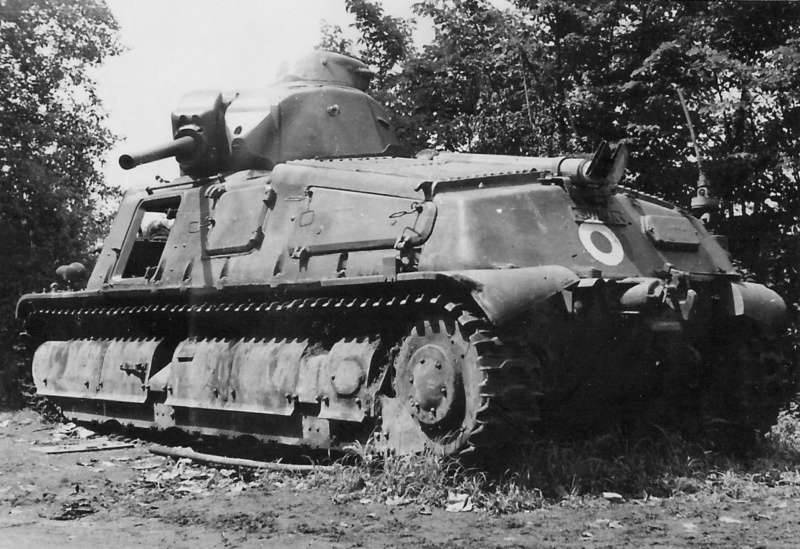
Wounded "Somau" S-35
Meeting with stubborn resistance on one of the sites, the Germans tried to bypass him immediately, break through to the rear of the enemy and seize his supply bases and lines of communication. As a result, the victorious tanks found themselves without fuel and ammunition and were forced to capitulate, having exhausted all possibilities for further resistance. In addition, they were also not very unsuccessfully used, evenly distributed throughout the front, while the Germans collected them in one fist in the direction of the main attack.
In the summer battles of 1940, in France, tanks of the English Expeditionary Force also took part. But here, as it turned out, the problems with their use were no less. Thus, the British troops used double tanks Matilda MK. I with a combat mass of 11 tons and pure machine-gun armament. True, unlike Pz.I, their armor was 60 mm thick, but the speed was only 12 km / h, i.e. even less than that of R-35, so they could not bring any substantial benefits in this new, highly maneuverable war. The cruiser tank Mk.IV with a crew of four people with a combat weight of 15 tons had armor 38 mm thick, 40-mm cannon and machine gun, and even had a speed of 48 km / h. Another English cruiser, the A9 Mk.I with a crew of six people stationed in three towers, was very high-speed as on the Soviet medium tank T-28. The armament on it consisted of a 40-mm cannon, a machine gun paired with it and two more machine guns in the machine-gun turrets located on either side of the driver’s booth. The speed was 40 km / h. However, the maximum thickness of the armor was only 14 mm, besides, the tank was distinguished by a terrible design with a lot of “zaman” and angles that really attracted German shells, which is why almost every shot on this machine reached its goal.
Due to the fact that the British did not have high-explosive shells for 40-mm guns, they could not conduct effective fire on infantry. It was believed that with such a small caliber there was still no great benefit from them, and the British armed some of their “cruisers” with lightweight 76-mm cannons with a short recoil and even 95-mm howitzers. Their task was shooting high-explosive shells at enemy artillery positions, pillboxes and bunkers, as well as the defeat of enemy personnel. Due to the specifics of their combat missions, the British called the vehicles with such weapons tanks "close" support (or CS). Interestingly, in this approach to the use of tanks, they were by no means original, it suffices to recall the Soviet "artillery tanks" on the T-26 and BT chassis and even such a German tank as the Pz.IV with its short-barreled 75-mm gun. It turns out that of all the vehicles of the British tank park, only the A-12 "Matilda" Mk.II - 27-ton tank with a crew of four, 40-mm cannon and 78-mm armor in front was a really strong and hard-to-attack tank, although its speed was only 24 km / h on the highway and 12,8 km / h on rough terrain. Those. Again, this tank was not suitable for maneuver operations that were conducted in France by German tank corps.
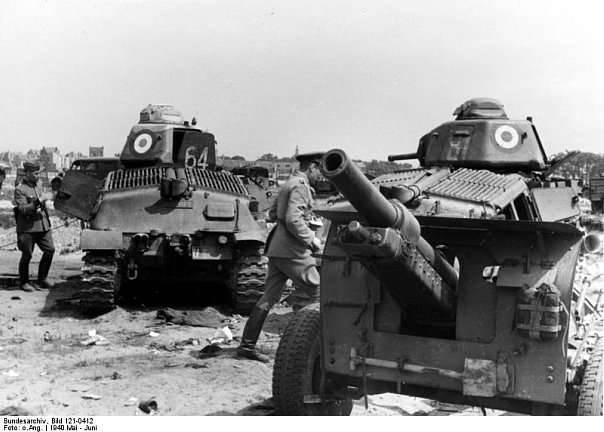
English and French trophies under Dunkirk.
However, even the British had very few of these tanks, since their own production of armored vehicles in England before the war was amazingly small: in the 1936 year, the 42 tank, 1937-32, in 1938-419, in 1939-969, and only 1940, after the fall of France, when it was necessary in the shortest possible time to compensate for the loss of tanks in the area of Arras, where 21 in May 1940, in order to delay the advance of German tanks to Dunkirk, a massive tank counterattack was launched. Nevertheless, the entire 58 tanks Matilda Mk.I and 16 Matilda Mk.II participated in it, and the defeat of the German tank forces in the area was not achieved.
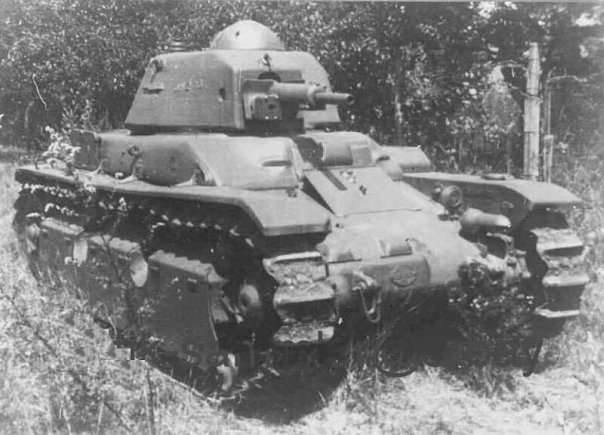
A typical French tank 1940. A lot of armor, little space and weapons.
Truly, with pitiful forces, the British “fell” on the German troops that day and, it should be noted that, despite the lack of air support and poor support by infantry forces, at the very beginning they were a complete success. The German 37-mm anti-tank guns and the 20-mm guns of the Pz.II tanks were completely powerless against the English armor, while the machine-gun British tanks quite successfully hit the gun crews, trucks and caused a strong panic among the German infantry.
However, the forces were still too unequal, and this time the successful attack of the thick-armored British cars from the very beginning was eventually repelled by 88-mm anti-aircraft guns and 105-mm field howitzers. It turned out that the 88-mm gun hits the A12 tank from a distance at which its 40-mm gun could not respond, and a larger caliber gun could not be placed on it because of the too small diameter of the shoulder strap of its turret. In turn, an increase in diameter inevitably had to be reflected in an increase in the width of the tank itself, which was hampered by ... the width of the railway gauge in England (1435 mm.). Interestingly, the same was the railway track in Europe. And there she also interfered with the Germans, because of which the same “Tigers” had to “change” into transport tracks for transportation by rail.
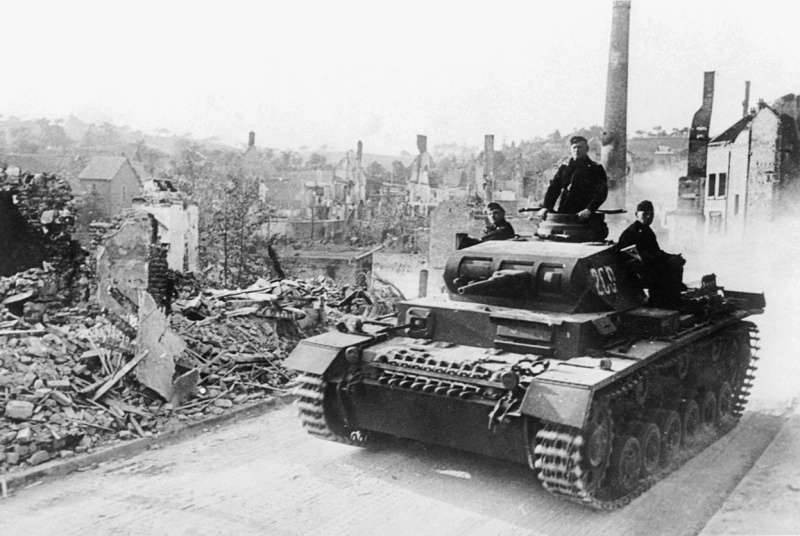
German tank Pz.III passes by a destroyed French village.
The result was a vicious circle, from which the British tried on the Matilda Mk.III tanks, which, as already noted, were armed with lightweight 76-mm cannons (CS). As a result, three people in the turret of this model of the Matilda tank were barely placed, the ammunition load had to be significantly reduced, and the combat capabilities of the tank diminished, since the lightweight projectiles of this gun practically did not have armor-piercing capability. Subsequently, the crews of the cruiser tank Mk.VI "Kruseyder" and the infantry Mk.III "Valentine" continued to suffer from the cramped turret, especially after they received new and large-sized 57-mm tank guns. Meanwhile, all that was then required to achieve the complete success of the British armored forces was tanks with 80-mm armor thickness and 57-mm caliber guns, which, if necessary, could be easily replaced with more powerful 75-76-mm guns!
Thus, as paradoxical as it may sound, the British were brought down by their railways, while the French became hostages of their outdated tactical principles and the costly fortified Maginot line at the border. By the way, the French designers managed to create very modern technically tanks in just a few pre-war years. But since they were forced to focus on the instructions of their military, they turned out cars that lost to the German blitzkrieg tanks. Having defeated France, the Germans captured approximately 2400 tanks from 3500 units of armored vehicles held by the French as trophies. The usual practice of using them has been the alteration or rearmament of captured vehicles. For example, on the basis of the B-1, the Germans were able to create a good flame-throwing tank, while the chassis of other machines were used to turn them into conveyors of ammunition and all sorts of ACS.
"Matilda" Mk.II: well, at least something ... But only for only two years!
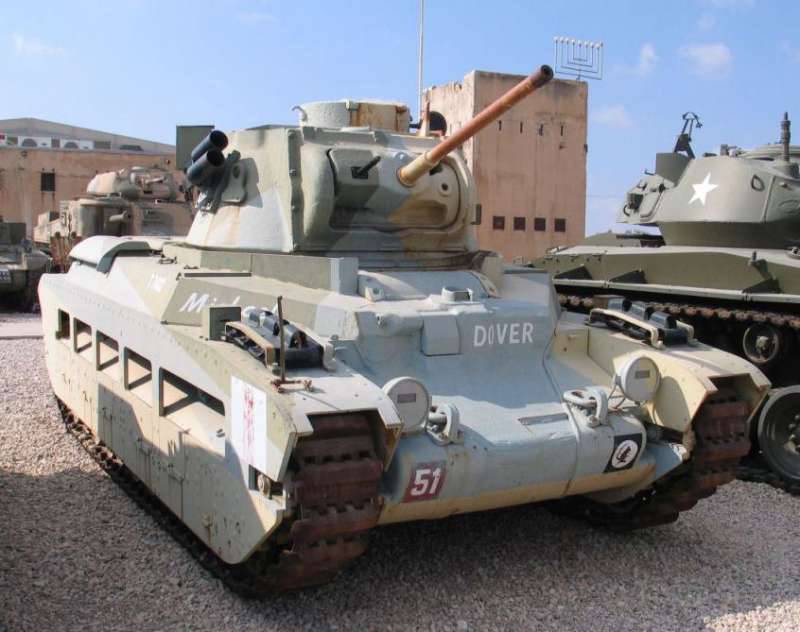
Information